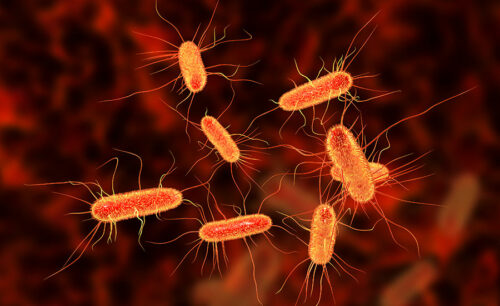Image Courtesy of Food Safety Magazine.
The latest advancements in synthetic biology allow researchers to engineer proteins with specific, desirable properties. These engineered biomaterials appear in implants, tissue generation, and drug delivery systems. However, most biomaterials are not electrically conductive, and most proteins that have been shown to be conductive are not well-characterized. Designing a protein-based biomaterial that is electrically conductive would be a large step in creating bioelectronic materials which can serve as an interface between organic materials, like the human body, and electronic materials, like implants or prosthetics. In a recent study published in Nature, researchers from Yale University engineered a highly electrically conductive protein nanowire that can be created and purified at scale from E. coli bacteria.
Daniel Shapiro YC’18, the first author of the paper, started this journey in his senior year at Yale College while working in Associate Professor of Molecular, Cellular & Developmental Biology Farren Isaacs’ synthetic biology lab. As a physics major, however, he wanted to bridge the two seemingly disparate fields of genetic engineering and physics. “I was walking along West Campus and saw a poster for a talk by Nikhil Malvankar, who was then a brand new professor, on electron conductance in bacterial proteins. I thought, ‘This is quantum biology. This is exactly what I want to do,’” Shapiro said. Shapiro reached out to Malvankar, and the two worked with Isaacs to develop a collaborative project focused on making proteins more conductive than usual, using Shapiro’s experience with synthetic biology to make mutations with non-standard amino acids (nsAAs).
The biomaterials Shapiro engineered in this research were E.coli pili, which are short, hair-like projections on the surface of the bacteria. They are a popular biomaterial to study because they can self-assemble into a robust filamentous shape, they show excellent material properties for a protein, and they can withstand a wide range of temperatures and pH conditions that normally degrade proteins. However, they are not electronically conductive. With this project, the researchers aimed to impart electrical conductivity into E.coli using three strategies.
Their first approach was to induce electronic conductivity in E. coli pili through amino acid mutations at the nanostructure level. The team tested protein building blocks of phenylalanine, tyrosine, histidine, and tryptophan. “This first part was [the hardest] because we had to figure out how to make, purify, store, and measure the conductivity of the protein,” Shapiro said. Nevertheless, they found that adding tryptophan increased electrical conductivity by 80-fold.
The team then came across a paper which showed that E. coli pili could be arranged into different geometric shapes, such as bundles, lattices, and cubes. “Nikhil saw this, and he was like, ‘Okay, what if we try that with our proteins – if we bundle E.coli pili, will that increase conductivity?’” Shapiro said.
The team found exactly that result. They aligned the pili into long, ordered bundles using a molecule called hexamethylenediamine (HMD). HMD can align the pili since it is positively charged at both ends while the pili is negatively charged, acting like a molecular ‘glue’ between the pili filaments. They found that assembling the pili increased long-range conductivity by five-fold. “If I had to guess why this happened, it’s because if the electrons flow down the outside of the proteins, then having a bunch of channels close together makes it easier to flow between filaments,” Shapiro said.
For the project’s final step, the researchers hypothesized that turning the pili into a scaffold onto which they could attach inorganic molecules may allow for higher electrical conductivity. This property would enable them to attach conductive materials, such as gold nanoparticles, to the filaments. “The hybrid organic-inorganic biomaterial property means you can use [the pili] as a scaffold…for gold nanoparticles to make it highly conductive, but in theory, you could attach it to whatever you want,” Shapiro said. To create this transformation to a scaffold protein, the researchers inserted a nsAA called propargyloxy-phenylalanine (PrOF) into the bacterial pili. This allowed the newly formed hybrid pili to bind with gold nanoparticles, which increased conductivity by 170-fold.
The applications for this research have widespread medical effects. “Having proteins that are electronically conductive lets you interface between your biological self and computers for medical care,” Shapiro said. The team hopes that their work can be the foundation for upcoming breakthrough innovations in protein nanowires and electrical conductivity.
Shapiro is now at Duke University, pursuing a Ph.D. in Biomedical Engineering and studying how liquid-liquid phase separation of intrinsically disordered proteins can be used to control gene expression.

